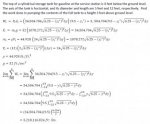I just worked through the following problem, and I was hoping someone could verify whether or not my answer is correct:
The top of a cylindrical storage tank for gasoline at the service station is 4 feet below the ground level. The axis of the tank is horizontal, and its diameter and length are 5 feet and 12 feet, respectively. Find the work done in pumping the contents of the full tank to a height 3 feet above ground level.
I've attached my work, which is admittedly sloppy with my steps in a weird order (I'm hoping you're able to make sense of it). The problem didn't state the density of gasoline, but after a google search and a quick conversion, I found it to be 44.928 lb./ft.^3. I use this value in my work. Also, my attachment doesn't include a visual of the problem, so I'll describe my approach. I oriented my coordinate axes with the origin at the center of the circular cross-section of the tank. This would imply that the gas is being pumped to a point 9.5 feet above the origin. When I evaluate my integral, I first split it into two integrals, then evaluate each using the fact that one represents the area of a semicircle, and the other is the integral of an odd function on an interval centered at zero (and hence, equals zero). The answer I ended up with was 3,218,116.824 ft.*lbs.
I'm not feeling uncomfortable with any of my steps, I would just like another pair of eyes to go over this and see if I made any mistakes anywhere (even in the basic number crunching). Thanks!
The top of a cylindrical storage tank for gasoline at the service station is 4 feet below the ground level. The axis of the tank is horizontal, and its diameter and length are 5 feet and 12 feet, respectively. Find the work done in pumping the contents of the full tank to a height 3 feet above ground level.
I've attached my work, which is admittedly sloppy with my steps in a weird order (I'm hoping you're able to make sense of it). The problem didn't state the density of gasoline, but after a google search and a quick conversion, I found it to be 44.928 lb./ft.^3. I use this value in my work. Also, my attachment doesn't include a visual of the problem, so I'll describe my approach. I oriented my coordinate axes with the origin at the center of the circular cross-section of the tank. This would imply that the gas is being pumped to a point 9.5 feet above the origin. When I evaluate my integral, I first split it into two integrals, then evaluate each using the fact that one represents the area of a semicircle, and the other is the integral of an odd function on an interval centered at zero (and hence, equals zero). The answer I ended up with was 3,218,116.824 ft.*lbs.
I'm not feeling uncomfortable with any of my steps, I would just like another pair of eyes to go over this and see if I made any mistakes anywhere (even in the basic number crunching). Thanks!

